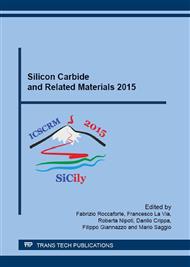p.201
p.205
p.209
p.213
p.217
p.221
p.225
p.229
p.233
Study of Ehrlich-Schwoebel Barrier in 4H-SiC Epitaxial Growths by Molecular Statics Method
Abstract:
A molecular statics method has been used to examine the Ehrlich-Schwoebel (ES) barrier for an adatom of 4H-SiC to diffuse from the {0001} to the {11-20} facet. As the calculated results shown, for the C-terminated surface, the inverse ES barrier exist for the silicon adatom, which could cause the step bunching; for the Si-terminated surface, ES barrier exist for the carbon adatom, which could cause the step meandering and result in the transition of step-flow growth to 2D-nucleation growth. Simultaneously, the C-terminated surface is more stable than the Si-terminated surface, which may be one reason that the quality of film grown on the carbon facet substrate is better.
Info:
Periodical:
Pages:
217-220
Citation:
Online since:
May 2016
Authors:
Keywords:
Price:
Сopyright:
© 2016 Trans Tech Publications Ltd. All Rights Reserved
Share:
Citation:


